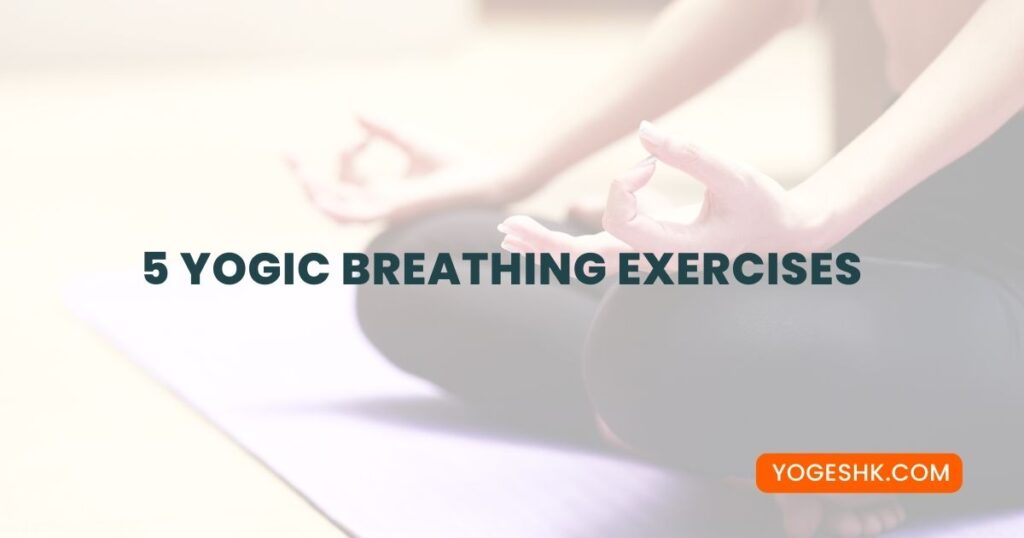
In ancient yoga, yogic breathing exercises, or pranayama, have been practiced for thousands of years. These exercises involve controlling and regulating the breath to improve physical, mental, and spiritual well-being. In recent years, scientific research has supported the many benefits of yogic breathing, making it a widespread practice for individuals seeking a natural and holistic approach to health and wellness.
Benefits of Practicing Yogic Breathing Exercises:
Yogic breathing exercises offer many benefits for the body and mind. These benefits include:
- Improved lung function and oxygenation
- Reduced stress and anxiety
- Lowered blood pressure and heart rate
- Improved digestion and metabolism
- Increased mental focus and concentration
- Enhanced immune system function
- Improved sleep quality
Based on Scientific Research:
The benefits of yogic breathing exercises are not just anecdotal – they are based on scientific research. Studies have shown that yogic breathing can positively impact the body’s autonomic nervous system, which regulates heart rate, digestion, and immune response. Research has also shown that regular yogic breathing can improve lung function and oxygenation, reduce stress and anxiety, and lower blood pressure and heart rate. As a result, many healthcare practitioners are now recommending yogic breathing as a complementary therapy for a wide range of conditions.
The Science Behind Yogic Breathing:
Yogic breathing is rooted in ancient Indian philosophy and promotes physical, mental, and spiritual well-being. However, in recent years, scientific research has helped to shed light on the physiological mechanisms behind the practice. Yogic breathing has led to increased recognition of the benefits of yogic breathing in both traditional and mainstream healthcare settings.
Role of the Autonomic Nervous System in Breathing:
The autonomic nervous system regulates many involuntary bodily functions, including breathing. The system is divided into two branches: the sympathetic and parasympathetic branches. The compassionate unit is responsible for the body’s fight-or-flight response, while the parasympathetic branch is responsible for the body’s rest-and-digest response. Yogic breathing exercises activate the parasympathetic branch, promoting relaxation and reducing stress.
Effects of Yogic Breathing on the Body:
Yogic breathing has several positive effects on the body, including improved lung function and oxygenation. Yogic breathing is essential because many yogic breathing exercises involve slow, deep breathing, which can help increase the amount of oxygen the body takes in. Additionally, yogic breathing reduces stress and anxiety, lowers blood pressure and heart rate, improves digestion and metabolism, and enhances immune system function. These effects are likely due to the activation of the parasympathetic branch of the autonomic nervous system. As a result, many healthcare practitioners are now incorporating yogic breathing into their treatment plans for a wide range of conditions.
What is work-life balance tips and guide?
5 Yogic Breathing Exercises:

Yogic breathing exercises, or pranayama, are essential to the ancient yoga tradition. These exercises involve regulating and controlling the breath to promote physical, mental, and spiritual well-being. There are many yogic breathing exercises, each with unique benefits. This post will explore five popular and practical yogic breathing exercises.
Kapalabhati (skull-shining breath):
Kapalabhati, also known as skull-shining breath, is a pranayama (breathing) technique that involves rapid and forceful exhalations through the nose. Kapalbhati generates by using a quick contraction of the lower belly muscles, which helps to expel stale air and toxins from the lungs.
To perform Kapalabhati, sit comfortably seated with the spine straight and the hands resting on the knees or thighs. Take a deep inhalation through the nose, then exhale sharply and forcefully through the nose while simultaneously contracting the lower belly muscles. Repeat this process for several rounds, taking short inhalations and forceful exhalations.
Kapalabhati has numerous benefits for the mind and body. Here are some of the ways it can help improve your health:
- Clears the respiratory system: Kapalabhati helps to remove the respiratory system by flushing out stale air and toxins from the lungs. Kapalbhati can improve lung function, oxygenation, energy levels, and physical endurance.
- Boosts digestion: The rapid contractions of the lower belly muscles during Kapalabhati can help to stimulate digestion and relieve constipation, bloating, and other digestive issues.
- Increases energy: Kapalabhati is an energizing breath that can help to increase mental clarity, focus, and alertness. It can also help to reduce fatigue and improve overall energy levels.
- Reduces stress and anxiety: Kapalabhati has a calming effect on the mind, helping to reduce stress and anxiety. It can also help to improve mood and promote relaxation.
While Kapalabhati has numerous benefits, it is essential to note that it may not suit everyone. Those with high blood pressure, heart disease, epilepsy, hernia, or other medical conditions should avoid practicing Kapalabhati. Also, pregnant women should avoid this technique as it may cause uterine contractions.
In summary, Kapalabhati is a powerful breathing exercise that can help to improve lung function, boost digestion, increase energy levels, and reduce stress and anxiety. However, it is essential to practice this technique under the guidance of a qualified yoga teacher and to avoid it if you have any medical conditions that this type of Breathwork may aggravate.
Nadi Shodhana (alternate nostril breathing):
Nadi Shodhana, also known as alternate nostril breathing, is a yogic breathing technique that involves using the fingers to alternate breathing through each nostril. It is a calming and balancing practice that helps to reduce stress, improve focus, and balance the energy flow in the body.
To perform Nadi Shodhana, sit comfortably with a straight spine, close your eyes, and rest your left hand on your lap. With your right hand, bring your index and middle finger to your forehead and use your thumb to close your right nostril. Inhale deeply through your left nostril, then use your ring finger to close your left nostril and exhale through your right nostril. Inhale deeply through your right nostril, then use your thumb to close and exhale through your left nostril. It is one cycle of Nadi Shodhana. Repeat for several cycles, alternating the nostril you inhale through.
The benefits of Nadi Shodhana are numerous. It helps to balance the autonomic nervous system, reduce stress and anxiety, and improve overall lung function. Balancing the energy flow in the body can also improve mental clarity, focus, and concentration. It can also help reduce tension headaches, lower blood pressure, and enhance sleep quality.
However, there are certain precautions to be aware of it. If you have any medical conditions affecting your breathing, such as asthma or chronic obstructive pulmonary disease (COPD), you should consult your doctor before attempting this exercise. Similarly, if you have any issues with your nasal passages, such as a deviated septum or sinusitis, you may need to modify or avoid the practice altogether.
In conclusion, Nadi Shodhana is a potent yogic breathing exercise that can help to balance the body and reduce stress. Regular practice can improve overall lung function, mental clarity, and focus. However, before attempting this exercise, it is essential to be mindful of any medical conditions or limitations.
Bhramari (bee breath):
Bhramari, also known as bee breath, is a pranayama (yogic breathing) technique that involves humming while breathing out. The name “Bhramari” comes from the Sanskrit word for “bee,” as the sound made during the practice resembles the buzzing of a bee. This technique is powerful for reducing stress and anxiety, improving concentration and focus, and promoting relaxation.
To practice Bhramari:
- Find a comfortable seated position with your eyes closed.
- Take a deep breath through your nose, then hum like a bee as you exhale. You can do this by keeping your lips closed and making a sound in the back of your throat.
- Repeat for several breaths, and then take a moment to observe how you feel.
Bhramari has numerous benefits for both the mind and body. One of its primary benefits is its ability to reduce stress and anxiety. By creating a sound vibration, Bhramari activates the parasympathetic nervous system, which is responsible for the body’s “rest and digest” response. Bhramari can help calm the mind and reduce tension and anxiety.
In addition to its stress-reducing benefits, Bhramari can help improve concentration and focus. The humming sound during the practice can help drown out distracting thoughts and create a sense of inner direction and clarity.
Bhramari may also be beneficial for those who suffer from tension headaches, as it can help to reduce muscle tension in the neck and shoulders. Additionally, by promoting relaxation, Bhramari may improve sleep quality and reduce insomnia.
While Bhramari is generally safe for most people to practice, there are a few precautions to remember. Those who suffer from chronic migraines or other types of headaches should avoid this technique, as the humming sound can exacerbate these conditions. Additionally, those with ear infections or other ear-related issues should avoid Bhramari, as the sound vibration can cause discomfort. As with any new yoga practice, checking with your healthcare provider before beginning is always a good idea.
Ujjayi (ocean breath):
Ujjayi Pranayama, also known as “ocean breath,” is a type of yogic breathing technique that involves a deep, controlled breath through the nose, with a slight constriction at the back of the throat, producing a soft hissing or ocean-like sound. This technique is commonly used in various yoga practices and has numerous physical and mental health benefits.
The benefits of Ujjayi Pranayama include the following:
- Improves lung capacity: Ujjayi breathing involves deep inhalations and exhalations, which helps improve lung capacity and oxygenation.
- Reduces stress: The controlled breathing and the sound produced during Ujjayi Pranayama can calm the nervous system, lessening stress and anxiety.
- Regulates blood pressure: Deep breathing in Ujjayi Pranayama can help to regulate blood pressure by increasing circulation and reducing stress.
- Improves focus and concentration: The rhythmic breathing and the sound of Ujjayi Pranayama can help improve focus and concentration, benefiting many aspects of life.
- Enhances digestion: Ujjayi breathing helps to increase oxygenation and circulation in the body, aiding digestion and reducing inflammation in the digestive tract.
- Stimulates the thyroid gland: The constriction of the throat during Ujjayi Pranayama can stimulate the thyroid gland, which regulates metabolism and energy levels in the body.
However, Ujjayi Pranayama is not suitable for everyone. Individuals with respiratory conditions such as asthma or chronic obstructive pulmonary disease (COPD) should avoid this technique as it may exacerbate their symptoms. Additionally, those with low blood pressure should practice Ujjayi Pranayama with caution and under the guidance of a certified yoga instructor.
Ujjayi Pranayama, or ocean breath, is a simple yet powerful breathing technique that can improve lung capacity, reduce stress, regulate blood pressure, improve focus and concentration, enhance digestion, and stimulate the thyroid gland. However, consulting with a healthcare provider and working with a certified yoga instructor is important before incorporating this technique into your daily routine.
Shitali (cooling breath):
Shitali, also known as the cooling breath, is a yogic breathing technique that can help to cool the body and calm the mind. This technique involves curling the tongue to form a tube and inhaling deeply through the mouth, followed by a slow exhale through the nose.
Benefits of Shitali:
- Cooling and soothing effect: Shitali is known for its cooling and soothing effect on the body and mind, making it an ideal technique for hot weather or after strenuous physical activity.
- Reduces stress and anxiety: The slow and deep breathing involved in Shitali can help to reduce stress and anxiety by calming the nervous system and promoting relaxation.
- Improves digestion: This breathing technique has been shown to improve digestion by increasing saliva flow and stimulating the digestive system.
- Relieves headaches: Shitali can effectively relieve tension headaches by promoting relaxation and reducing muscle tension in the head and neck.
- Lowers body temperature: Shitali can help to reduce body temperature, making it a helpful technique for those with fever or hot flashes.
Who Should Not Do Shitali:
While Shitali can be beneficial for most people, some should avoid this breathing technique:
- For those unable to curl their tongue: Shitali requires the ability to bend the language into a tube, so those unable to do so should avoid this technique.
- Those with low blood pressure: Shitali can cause a temporary drop in blood pressure, so those with low blood pressure should avoid this technique or practice it cautiously.
- Those with respiratory problems: Shitali involves inhaling through the mouth, which can be problematic for those with respiratory issues such as asthma or chronic obstructive pulmonary disease (COPD).
- In summary, Shitali is a potent yogic breathing technique that can help to cool the body, calm the mind, and promote relaxation. It can benefit most people, but those with certain health conditions should exercise caution or avoid this technique altogether. As with all yogic breathing techniques, starting slowly and listening to your body to ensure you practice safely and effectively is essential.
By incorporating these five yogic breathing exercises into your daily routine, you can experience many physical and mental benefits that can improve your overall health and well-being.
Tips for Practicing Yogic Breathing
In this post, we have covered the science behind yogic breathing exercises, discussed the benefits of each exercise, and provided step-by-step instructions for each technique. In this section, we will offer tips for practicing yogic breathing and how to incorporate it into your daily routine, as well as advice for beginners on getting started with these exercises.
Suggestions for how to incorporate yogic breathing exercises into your daily routine:
- Practice in the morning: Start your day with yogic breathing exercises to energize your body and set a positive tone.
- Take breaks throughout the day: Incorporate short breathing exercises into your workday to help reduce stress and improve focus.
- Practice before bed: End your day with relaxation techniques like yoga nidra or deep breathing to help you wind down and prepare for sleep.
Advice for beginners on how to get started with yogic breathing:
- Start slowly: Begin with simple exercises like deep breathing before moving on to more advanced techniques.
- Find a comfortable position: Whether sitting or lying down, find a place to relax and focus on your breath.
- Please don’t force it: Allow your breath to flow naturally, and avoid straining or pushing yourself.
- Seek guidance: Consider taking a yoga class or working with a certified yoga instructor to learn proper techniques and receive personalized advice.
By incorporating yogic breathing exercises into your daily routine and following these tips for getting started, you can experience these powerful techniques’ numerous physical and mental benefits.
Conclusion

In this post, we have discussed the science behind yogic breathing exercises, the benefits of each exercise, and provided step-by-step instructions for practicing them. This post will offer tips for incorporating these exercises into your daily routine and advice for beginners on how to get started. In this section, we will summarize the benefits of practicing yogic breathing exercises and encourage readers to try for improved health and well-being.
Summary of the benefits of practicing yogic breathing exercises:
- Reduces stress and anxiety
- Increases oxygenation and lung function
- Boosts circulation and detoxification
- Improves focus and concentration
- It calms the mind and reduces tension headaches
- Enhances digestion and reduces inflammation
- Aids in better sleep
Encouragement to give these exercises a try for improved health and well-being:
By practicing these simple and effective breathing exercises, you can experience numerous benefits for the mind and body. Whether you seek stress relief, improved focus, or better sleep, yogic breathing exercises can be powerful. We encourage you to incorporate them into your daily routine for improved health and well-being.
